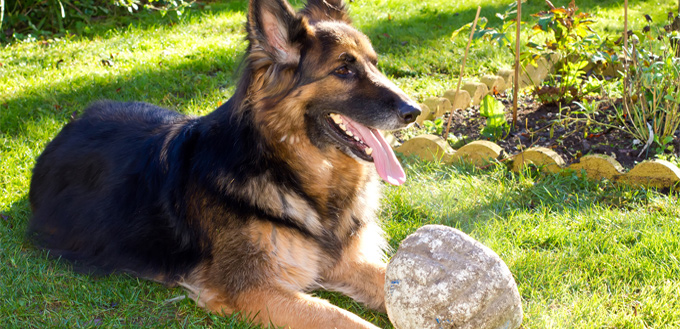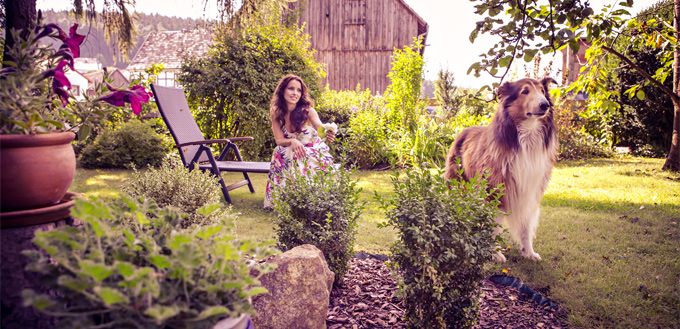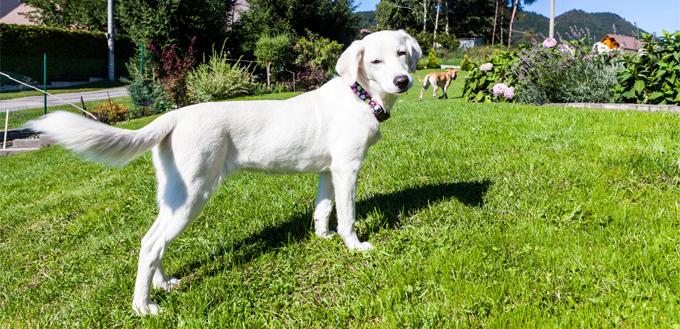While you’ve spent hours to keep your garden tip top, a moment’s negligence and your canine has managed to wreck a havoc there. Is your dog always up to some mischief the moment he/she steps into the garden? In that case, there are a lot of things you can do to maintain harmony between your plants and your furry best friend. You may start by making your garden dog-friendly.
Here are a few simple steps to plant a dog-friendly garden.

1. Fencing
This is the simplest option. You can start by putting a 16-inch affordable fence that will keep any small-medium sized dogs (or even larger ones) out of the garden area. The fence creates a boundary and makes it easier for you to train your canine to keep out of the area. Plus, if you notice your dog trying to eat any of the fruits or vegetables from your plants, you might even need a chicken wire to avoid that from happening. To stop your dog from escaping, you may also want to try an electric dog fence to stop them from running away.
2. Build a Path
Your dog will need a trained pathway to walk to the garden, otherwise, they will beeline to wherever they want to head towards in your garden. It’s better to permanently install a pathway with stepping-stones or pavers so that your canine doesn’t step into the dirt trail. If your garden is comparatively small, pathways made of stepping-stones or bricks are budget friendly and easier to maintain as well.
3. Secure a Compost Bin
A compost bin is a must for your garden. Why? Well, the food that you scrap are usually fruits and vegetables from your own garden that might have rotten and will undoubtedly catch your curious friend’s attention which can be extremely harmful to them if ingested. Foods such as avocados, raisins, grapes, onions or lemons can be especially harmful and therefore need to be kept out your dog’s reach at all times. It is your responsibility to make its way to the compost bin, rather than anywhere else.
4. Create a Play Zone for Your Dog
For all you know, to your dog, your garden is their Disney land! Make sure that your gardening area with all your plants and vegetation is at one side and your dog has their own play area detached somewhere else. Take out some time out of your busy schedule and play with your dog or take them for a walk in your own garden every day. That way, you can train your dog not to enter the restricted plant area. Only proper training will help them from destroying your gardening efforts. Who knows, your furry friend might even help you out with gardening from time to time, instead of ruining it. You could also use a dog playpen to provide an area for them to play in.
5. Build a Kennel
Your dog will not ruin your garden if they have a place of their own in it. Although your whole house belongs to your furry friend, they will also try to get their rights over your garden. Before they try and claim a spot of their own, you should build a kennel or get them a dog house beforehand and give them their own space so that they don’t create a chaos in the area where you have your plants.
6. Avoid Non-organic and Chemical Fertilizers
Forget non-organic fertilizers, even organic fertilizers are harmful to your dog. Dogs have a tendency to lick everything that they find attractive. The fruits in your garden are no exception. In that case, they might try licking or even eating one or two of your fruits. While you might be unaware of that, it may already be causing uneasiness to your canine. It’s always better to organically maintain your plants, rather than using any chemical fertilizers, especially if you have a pet roaming around your garden area all the time.

7. Mind Your Mulch
Mulch is your ultimate way of maintaining a healthy garden that keeps your soil hydrated and suppresses unwanted weeds. While mulch is a good way to nourish your garden, it could be hazardous for your pet dog. Why? Because if you consider cocoa mulch, it is made of cocoa beans. These beans contain theobromine that is extremely toxic for your canine. If your dog swallows even a little bit of these toxic mulch, they are likely to suffer from vomiting, diarrhoea or even death. So even if you are putting mulch in your garden area, ensure it is odour free and in a very small amount.
8. Take Note of the Surfaces
Your garden is likely to have a lot of sharp tools and edges, which makes it an unsafe place for your pet to wander around. You are to take responsibility to keep the tools away from your dog’s reach. Plus, make sure that the sharp edges of the fences are not too sharp, which may hurt your dog in any way.
9. Add a Marking Post
This is where your dog will mark their territory and not victimize your plants. Adding a marking post only for your dog will surely make them happy and content. Plus, giving them their own space will allow them to do their business only in that area, while you are free to protect your plants from your dog’s grasp.
10. Know Dog-safe Plants
Some plants are poisonous to keep in your garden, especially if you have a dog, while others are dog-friendly. Make sure to do your research before planting any unknown herb, which might be toxic for your canine. Always take an extra step of precaution and ensure that the plants you have in your garden are dog-friendly.
Here are some plants that you should avoid growing in your garden if you have a dog:
- Daisy: Many of us might have already planted this flower in our respective gardens, however, it contains specific substances that are toxic for your canine.
- Aloe Vera: This is so useful for our skin and burns, but little did we know that it is not so useful for our furry friends. If they accidentally swallow or chew the leaves or the Aloe Vera itself, it could possibly lead to vomiting, tremors and diarrhoea.
- Daffodils: These pretty flowers make our garden look bright and cheerful. However, if your pet munches on it, it will cause convulsions, vomiting, cardiac issues and diarrhoea.
- Tulip: These cup-shaped flowers are bound to attract your canine. And If they gobble one or two of these flowers, it could lead to extreme gastrointestinal uneasiness.
- Tomatoes: Do you love fresh tomatoes and planning to plant a tree in your garden? Make sure you keep an eye on it from time to time because your favourite plant contains solanine and is highly toxic for your dog.
- Mint, Parsley and Oleander: A small amount of mint might freshen up your pup’s breath, but these leaf-like plants might have a negative reaction in your canine’s stomach, causing vomiting or weakness. In that case, call your vet immediately!
- Oak Trees: Oak leaves and acorns contain a combination of harmful acids that are potentially poisonous for your dogs. If your dog has eaten any of those acorns, the symptoms would include stomach discomfort and vomiting.

Is Garden a Safe Place for My Dog?
If you ask your friends whether they take their dogs out in their garden or not, most of them would say no because of all the things that could go wrong. However, the answer to the question is yes- you can always take your canine out for a walk in the garden, but you need to keep a close eye on them at all times. Your garden is a great place for you and your dog to hang out with fresh air and greenery all around. It’s no surprise that that from time to time, you dog will find a way out of the house and sneak into your garden to cause some innocent mischief. Therefore, it’s better if you could make it a routine to take them out for a walk and let them do their “business” in the evening.
Have you taken your furry friend out to your garden? Share your pictures with us! We’d love to see.
Sources:
- Sherry Woodard, How to Get a Dog to Stop Digging, Best Friends Animal Society
- Pets and Produce: Top Tips on Vegetable Garden Safety, ASPCA






